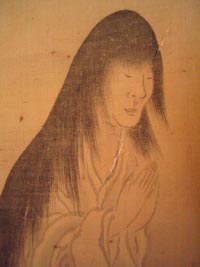OKIJIMA II: Seeking the Far Shore
 When we entered the temple grounds there was much carpentry going on; we called into the open doorway of the priest's house next door in the compound, and a young man came out who was the son of the priest; he would be the next priest. He was now studying at a Buddhist University in Kyoto. When we began to ask questions about the Rennyo connection, he took us inside the temple, which was being refurbished, and into a side room at the front of which were three scroll altars and two long brightly colored scrolls hanging on a side wall, divided into different 'panels.' They told a story, which the young man related to us.
When we entered the temple grounds there was much carpentry going on; we called into the open doorway of the priest's house next door in the compound, and a young man came out who was the son of the priest; he would be the next priest. He was now studying at a Buddhist University in Kyoto. When we began to ask questions about the Rennyo connection, he took us inside the temple, which was being refurbished, and into a side room at the front of which were three scroll altars and two long brightly colored scrolls hanging on a side wall, divided into different 'panels.' They told a story, which the young man related to us. Back during the Muromachi Period, when civil war (in this instance, likely the Onin War) raged throughout Japan, several defeated warriors were exiled to Okijima, which was then uninhabited.
The warrior of our story, the ancestor of the fellow who was telling it to us, thus left the trappings of war behind and became a fisherman, taking a local fisherman's daughter as his wife. Sadly, she died soon after giving birth to their only son, but death did not bring an end; instead her unhappy ghost kept returning each night to breast feed the child. Her ghostly presence night after night was not only very personally disturbing to the man, but the anguished spirit of his beloved wife was unable to move on to the Pure Land, where she would be at peace.

One night in this time of misery a god visited the man in a dream and told him to await the arrival of a very wise individual, who would come to the island. Every day thereafter the fisherman went to the beach and waited. One day during a great storm, when arrivals were least likely, a boat that had been on its way to Katata across the Lake was forced to seek shelter at Okijima; the boat's passenger was the renowned Rennyo Shonin.
The fisherman invited Rennyo to stay at his house till the storm had abated; during that time he told the monk his tale. That night they waited up for the ghost of the woman to appear; when at last she appeared and reached for her infant son, Rennyo told her that to free her spirit from its earthly tether and gain entry to the Pure Land all she had to do was chant namu-amidabutsu (I take refuge in Amida Buddha). But she didn't believe him; she refused to chant, saying that she was but a woman, that mere prayers would not work for her. Rennyo assured her that this prayer would, if she'd but try it; to make it easier, he wrote it out on a scroll for her to read. She did so, over and over until her voice became a chant, under whose power she entered the Pure Land, never returning to haunt this troubled world again.
 The original scroll written by Rennyo in the 'dancing tiger' calligraphic style still hangs in the temple, which that very warrior-fisherman founded as a result of these events. The young man telling us the story was the 19th generation of the family begun by that man, and the 18th generation of a boy who had been suckled by a ghost. At that point the sun suddenly disappeared behind some clouds and it got very chilly inside the unheated room.
The original scroll written by Rennyo in the 'dancing tiger' calligraphic style still hangs in the temple, which that very warrior-fisherman founded as a result of these events. The young man telling us the story was the 19th generation of the family begun by that man, and the 18th generation of a boy who had been suckled by a ghost. At that point the sun suddenly disappeared behind some clouds and it got very chilly inside the unheated room. When we went into the darkening day pondering this tale, we hadn't far to go to reach the other side of Buddha's neck; from there we walked the long walkway that traced Buddha's shoulder, pausing now and then to gaze out into the air in search of our mountains and our home, but they were not there. Where they should have been was a dense haze, beyond which might be mountains...
We walked past all the lakeside gardens to the very end of the windy pathway, and there clambered up the steep slope into the lee shelter of a grand old gnarled tree, where we sat amid the small mountainside gardens and ate our lunch, looking often into the distance for some small sign out there of where we lived, but it was all impenetrable whiteness...


















No comments:
Post a Comment